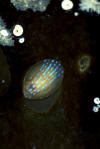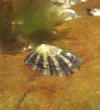|
The word mollusc comes from the Latin mollis meaning soft and
refers to the soft bodies of these animals. The body form of molluscs varies
widely but they normally have a head with eyes and tentacles, a muscular foot
and a visceral mass containing the digestive and reproductive organs. They often
have a shell formed in either one or two parts to protect their soft bodies.
Molluscs found in the sea include the bivalve shells, sea snails and sea slugs.
 Dog whelk Nucella
lapillus (Linnaeus) Dog whelk Nucella
lapillus (Linnaeus)
Dog-whelks are predators of barnacles and
mussels. They bore into mussel shells using a combination of mechanical and
chemical means, while they attack barnacles by pushing open these crustaceans'
plates. It may take a day for a dog-whelk to eat one barnacle and a week for it
to eat a mussel.
In spring, dog-whelks may be found mating in large aggregations and thousands of
eggs are laid in vase-shaped capsules. Only a few of these eggs will hatch out
into baby snails, however; the rest serve as food for the fertile eggs.
In the 1970’s and 1980’s, dog-whelks were affected by the toxic anti-fouling
paint tributyl-tin (TBT). This paint was commonly used to prevent the
colonisation of animals and plants on the bottoms of boats. Female dog-whelks
exposed to TBT were shown to develop male characteristics such as a penis and
finally became sterile. As a result the dog-whelk population around the
south-west declined.
 Blue rayed limpet
Helcion pellucidium (Linnaeus) Blue rayed limpet
Helcion pellucidium (Linnaeus)
Close inspection of the fronds or holdfasts of oarweed
(Laminaria digitata) may reveal the beautiful blue rayed limpet. These limpets
often live in small groups and slowly chew their way into kelp plants. The holes
made in the holdfast by the feeding activity of the limpets are believed to
weaken the plants and together with wave action may result in the death of the
kelp.
The limpets found in the kelp holdfasts are a different variety from the ones
found on the fronds. Instead of a transparent shell covered in iridescent blue,
broken rays, the shells of the holdfast dwellers are opaque brown with numerous,
although sometimes inconspicuous, blue rays that alternate with reddish-brown
rays. These differences are believed to be connected with their different
habitats.
 Thick topshell
Monodonta lineata (Da Costa) Thick topshell
Monodonta lineata (Da Costa)
The thick topshell is a southern species only found on the coasts of
south-west Britain, although it does occur on Atlantic coasts further south.
Laboratory experiments have shown it to have higher heat tolerance than the
purple topshell (Gibbula umbilicalis) and the grey topshell (Gibbula cineraria).
It often lives higher up the shore than these other two topshells in the summer,
although, in the winter it will move lower down the shore.
On the north coast of Cornwall and in the Isles of Scilly it appears to replace
the edible winkle (Littorina littorea). It is collected for food in the Isles of
Scilly.
Lines on the shell can be used to age these animals and longevity may be ten
years or more.
Like other topshells it feeds on detritus and micro-organisms.
 Flat or purple top-shell
Gibbula umbilicalis (da Costa) Flat or purple top-shell
Gibbula umbilicalis (da Costa)
The purple top-shell only occurs on the south-west and west coasts of
Britain.
Laboratory experiments have found its heat tolerance to be greater than the grey
topshell (Gibbula cineraria) but lower than the thick top-shell (Monodonta
lineata). This may explain why it is found at a shore level in between the
levels at which the other two topshell species occur.
The purple top-shell is mature after two years, when it is about 1 cm high.
There are both male and female top-shells and fertilization is external. The
eggs hatch out into free-swimming larvae which settle after a few days. The
purple top-shell is believed to live for more than eight years.
Like the grey topshell (Gibbula cineraria) it feeds on micro-organisms and
detritus.
 Common limpet Patella
vulgata (Linnaeus) Common limpet Patella
vulgata (Linnaeus)
When the tide is out most limpets are clamped tightly to
rocks. At high tide, however, they undertake feeding excursions. The common
limpet feeds on a wide range of seaweeds. These are scraped off the rocks using
a rasping tongue-like organ called a radula. This rasping activity may leave
behind zig-zag markings. They also leave behind a mucous trail which they use to
return to the same ‘home’ spot. On soft rock, the abrasion between the limpet
shell and the rock, at its ‘home’, results in the formation of a shallow
depression or ‘home scar’. On hard rock, the shell will be worn down to make the
shell fit perfectly into the rock. This reduces the rate at which water is lost
from the animal during emersion.
Limpets may be preyed upon by birds, crabs, starfish and whelks. However, they
are not completely defenceless. In response to the presence of the common
starfish (Asterias rubens), the common limpet can raise its shell and rock from
side to side sometimes suddenly smashing the edge of the shell down on the
predator.
The length of life of the limpet depends on the conditions in which it grows. If
conditions lead to fast growth it may only live between four and five years.
However, if conditions are such that it grows slowly it may live as long as
seventeen years.
In the south-west the close relatives of Patella vulgata, Patella aspera and
Patella depressa (a southern species), are also common. To tell the difference
between these species the limpets need to be dislodged from the rock so that
their feet may be observed. Patella aspera has a vivid orange or pink foot.
Patella depressa has a blackish foot, while Patella vulgata usually has an
olive-green foot.
 Grey top-shell
Gibbula cineraria (Linnaeus) Grey top-shell
Gibbula cineraria (Linnaeus)
Gibbula cineraria (Linnaeus)
The grey top-shell is common on rocky shores off the south-west coast and all
around the British coast. They live lower on the shore than purple top-shells (Gibbula
umbilicalis) and thick top-shells (Monodonta lineata). In fact, they appear to
prefer to live under water, although they are found on the lower shore. Grey
top-shells have been observed to migrate up shore at dawn and return to the sea
at dusk.
There are both male and female grey top-shells and fertilization is external.
The eggs of the grey topshell hatch into free-swimming larvae. They are
dispersed in the currents for a week or two before settling on the seabed.
The teeth of top-shells are not as sharp as that of the limpet and, therefore,
they are unable to eat tough seaweeds. Instead, they eat mainly microorganisms
and detritus.
 Edible or common periwinkle
Littorina littorea (Linnaeus) Edible or common periwinkle
Littorina littorea (Linnaeus)
The edible periwinkle is common all around Britain despite
extensive gathering for food. In the south-west it is collected for food in the
Exe, Teign and Falmouth areas.
This periwinkle matures at about three years of age and when its shell is about
1.2 cm high. The sexes are separate and copulation and internal fertilization
occur. During a spring tide the eggs are released and taken into the open water.
The eggs hatch into larvae and after a couple of months settle on the shore. The
winkle may live for more than five years.
The edible periwinkle feeds on soft seaweeds, such as sea lettuce (Ulva lactuca)
and Enteromorpha intestinalis. It also grazes on micro-organisms and detritus.
 Flat periwinkle
Littorina obtusata/mariae (Linnaeus) Flat periwinkle
Littorina obtusata/mariae (Linnaeus)
Flat periwinkles are found in high abundances amongst the
fronds of the knotted wrack (Ascophyllum nodosum), the serrated wrack (Fucus
serratus) and the bladder wrack (Fucus vesiculosus). The winkles feed on these
seaweeds and also lay their eggs on the fronds. There are both male and female
flat periwinkles and copulation and internal fertilization occur. After four
weeks the eggs hatch out into small crawling winkles. Another periwinkle, called
Littorina mariae is similar to Littorina obtusata and may also be found amongst
the fronds of the serrated wrack. This latter winkle does not feed directly on
the wrack but on small seaweeds growing on the wrack. It is slightly smaller
than Littorina obtusata and has a smaller shell opening.
The shells of the flat periwinkles come in a variety of bright colours and
patterns. Green shelled winkles dominate sheltered shores while patterned
brown-shelled winkles dominate exposed shores. These differences are believed to
be somehow connected to visual selection by predators such as the shanny (Lipophrys
pholis).
 Common mussel
Mytilus edulis (Linnaeus) Common mussel
Mytilus edulis (Linnaeus)
Mussels attach themselves to rocks and each other using
sticky threads called byssus. Sometimes they live in large aggregations. These
mussel beds are fished commercially. Their main predators, other than humans,
are the common starfish, the dog-whelk, the shore crab and the oystercatcher. It
has been shown that mussels can sometimes defend themselves against dog-whelks.
They do this by attaching large numbers of threads to the whelk, eventually
pulling it over.
Mussels feed on particles in the water. Water is drawn in through a gap in the
shell and expelled through an outflow tube. As well as extracting food particles
from the water they also extract any toxins. These toxins become concentrated in
their bodies. Scientists have found that measuring the toxin concentrations in
mussel tissues is a useful indicator of pollution in the surrounding waters.
The common mussel dominates the rocks of north Cornwall. The shells of the
mussels may act as a substrate for seaweeds and encrusting animals such as
barnacles, sponges
Common and widespread these bivalves have been eaten by humans since early times.
|